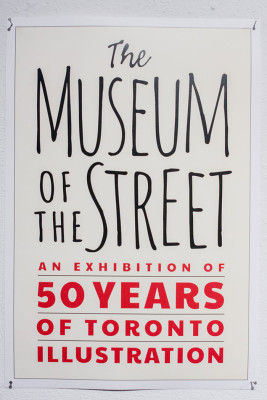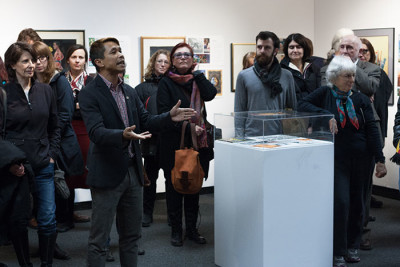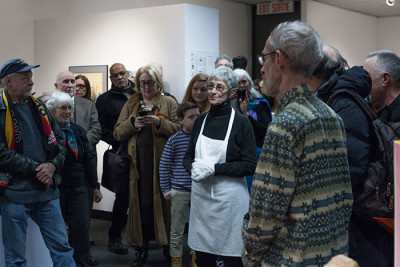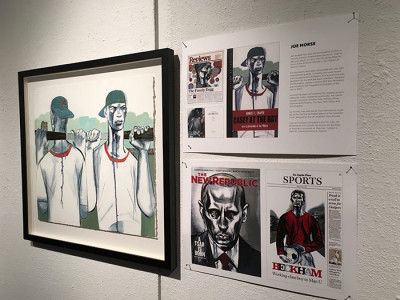Sheridan faculty showcased at illustration show
Toronto gallery packed for The Museum of The Street

The first of its kind, The Museum of the Street exhibit show cases 50 years of work by Toronto illustrators. Four of those featured are Sheridan faculty. (Photograph by Erin Queenan)
BY ERIN QUEENAN
Fifty years of Toronto illustration history was celebrated last Thursday at a first of its kind art exhibit showcased at the John B. Aird gallery downtown Toronto.
The Museum of The Street, curated by Bill Grigsby of Reactor Art Agency, and illustrator Gail Geltner, celebrated and preserved the works of 36 recognized Toronto illustrators, four of them Sheridan faculty members.
The illustration works, previously commissioned by book and magazine publishers, newspapers, advertising agencies and corporations reflected and explored ideas, trends and beliefs of society.
“I’ve always seen [illustration] as this art that’s everywhere. It’s a noun, an adjective and a verb,” says Joe Morse, Bachelor of Illustration program coordinator.
His work, as well as Illustration faculty member Blair Drawson, Sandra Dionisi and Bachelor of Animation faculty member Mark Thurman, were included at the exhibit.
The gallery located on Bay Street, next to the University of Toronto St. George campus, was packed with artists, patrons, students, family and friends celebrating the past, present and future of illustration in Toronto.
In an informal introduction, co-president of the gallery Jowenne Herrera welcomed and thanked everyone in the room for their attendance. “I’ve never seen this gallery so packed,” he said looking around at the jammed space. He also said how important illustrators are to Toronto’s culture. “It’s the artists that create the story and make it come alive.”

Co-president of the John B. Aird Gallery, Jowenne Herrera, welcomes and thanks everyone in the room for their attendance. (Photograph by Patrick Queenan)
Herrera called up the curators, Bill Grigsby and Gail Geltner to speak. The pair expressed their desire to see the works in the gallery find permanent homes in either museums or archives. Geltner closed by explaining how the last year of work putting together the exhibit, and working with other illustrators, changed the way she sees Toronto and the people in it.
“It was quite an extraordinary experience. It started as a solitary quest and grew. I’m looking forward to the opportunities this exhibit creates.”
The assembled guests and artists agreed. “I think they did a very good job with the exhibit,” said Joe Salina, a Toronto illustrator whose work has been commissioned by companies such as the CBC, Esquire, Globe and Mail, Macleans and Wall Street Journal. Salina was joined by his cousin, Jim McDonald, at the exhibit. He says he also knows Geltner from their days at OCAD University. “Most of the people here know each other. Word gets around,” said Salina.

Gail Geltner, centre, is the gallery curator and founder of the exhibit. (Photograph by Patrick Queenan)
“It’s a free event and it’s vital to keeping culture,” says Pamela Courtot, a Toronto resident. She came out to the exhibit with her daughter on the recommendation of an illustrator friend in Tennessee.
Joe Morse has worked with big international companies included Universal Pictures, Nike, Coca Cola, Target, magazines and newspapers including Rolling Stone, Entertainment Weekly, New York Times and the Guardian.

Joe Morse has worked for major sports teams, Universal Pictures, Nike, Coca Cola, Target and magazines and newspapers worldwide, including Rolling Stone, Entertainment Weekly, New York Times and the Guardian. (Photograph by Erin Queenan)
Morse remembers an American art director once asking him what made Canadian illustrators so good? He replied: Canada’s rich media landscape and tradition is rooted in innovative ideas, commentary and picture craftsmanship that made our works special. “We also live above this big animal that is the United States,” said Morse, with a smile.
Morse describes Sheridan’s Illustration program as cutting edge. What’s unique about it is that graduates can come out as either extraordinary drawers and painters, or designers skilled in interactive mediums. The program is incredibly versatile and is designed to make upcoming, trailblazing illustrators.
“Today there aren’t the same kind of barriers between commercial and fine art, all sorts of media are interacting with each other.”
The essence of The Museum on The Street is something Morse is excited about. “We have a culture now a day that’s interested in what’s new. But at the same time I think they should look back and recognize the lessons history offers.” The exhibit is a place to do just that.




